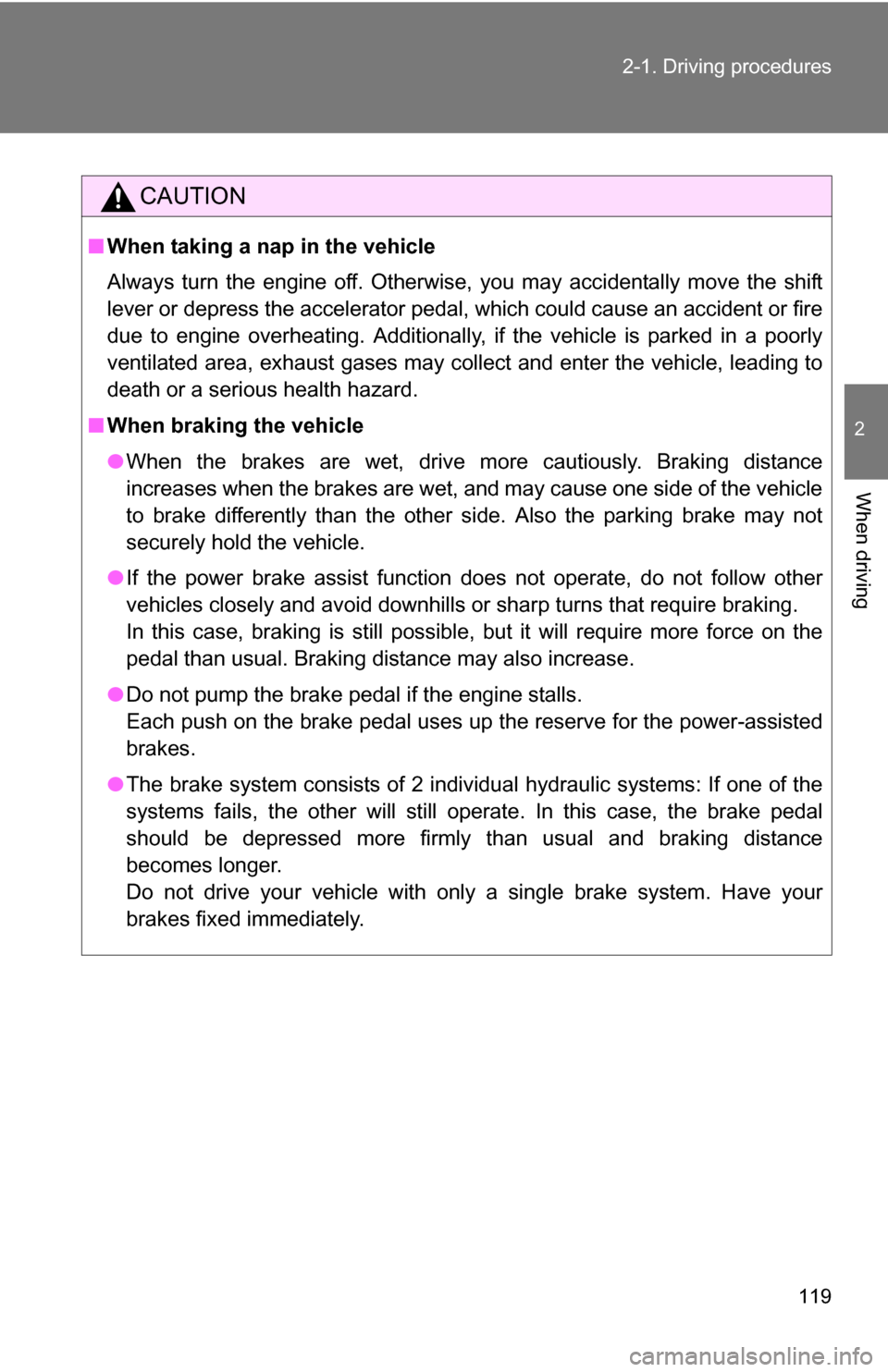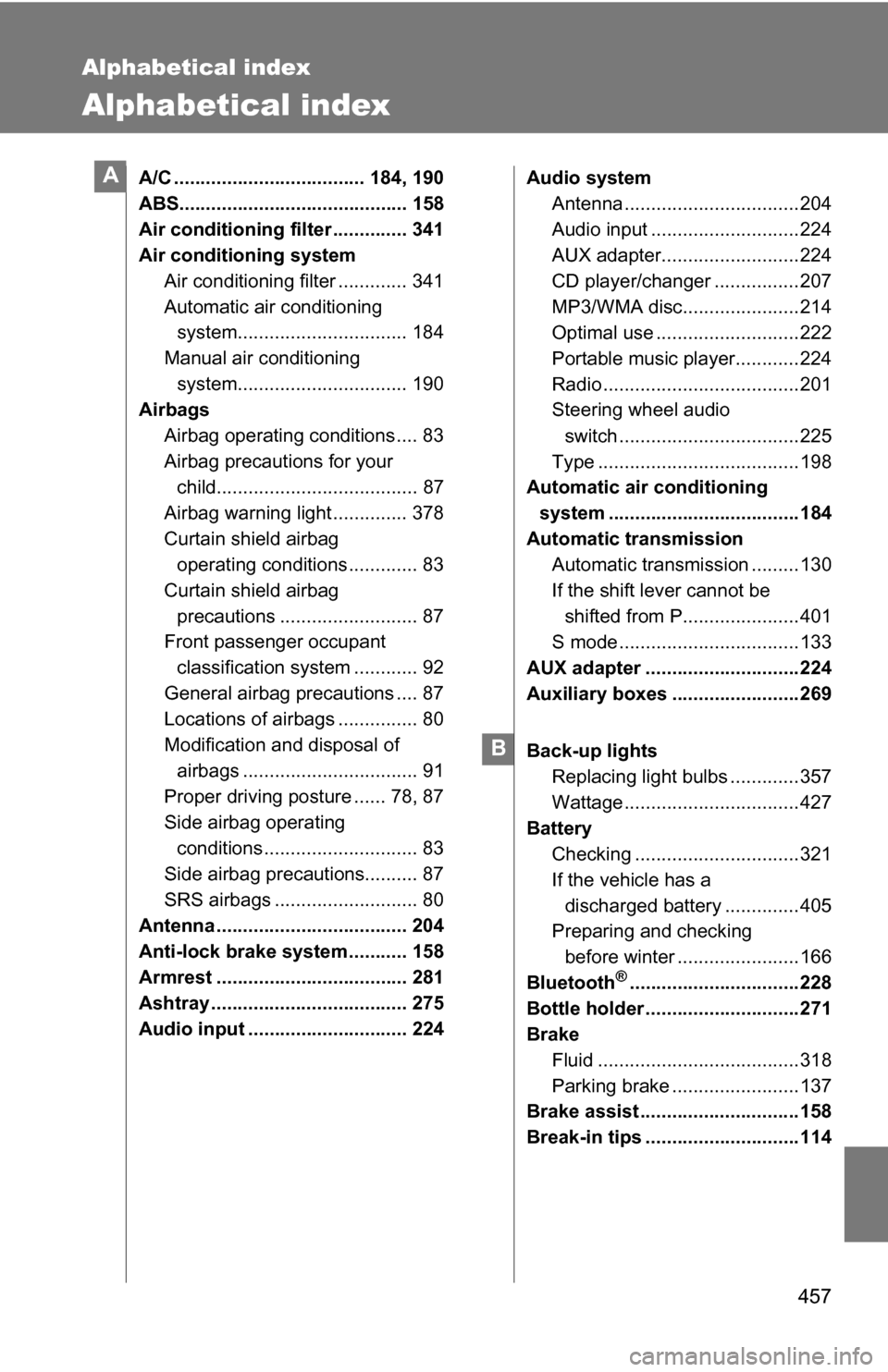Page 111 of 468

When driving2
111
2-1. Driving procedures ........ 112Driving the vehicle............ 112
Engine (ignition) switch (vehicles with smart
key system).................... 122
Engine (ignition) switch (vehicles without smart
key system).................... 126
Automatic transmission .... 130
Manual transmission ........ 135
Turn signal lever .............. 136
Parking brake ................... 137
2-2. Instrument cluster.......... 138 Gauges and meters ......... 138
Indicators and warning lights .............................. 142
Multi-information display............................ 146 2-3. Operating the lights and
wipers ........................... 150
Headlight switch ............... 150
Fog light switch ................ 152
Windshield wipers and washer ........................... 153
2-4. Using other driving systems ........................ 155
Cruise control ................... 155
Driving assist systems ..... 158
2-5. Driving information ........ 162 Cargo and luggage .......... 162
Vehicle load limits ............ 165
Winter driving tips ............ 166
Trailer towing ................... 170
Dinghy towing (automatic
transmission) ................. 178
Dinghy towing (manual transmission) ... 179
Page 119 of 468

119
2-1. Driving procedures
2
When driving
CAUTION
■
When taking a nap in the vehicle
Always turn the engine off. Otherwise, you may accidentally move the shift
lever or depress the accelerator pedal, which could cause an accident or fire
due to engine overheating. Additionally, if the vehicle is parked in a poorly
ventilated area, exhaust gases may collect and enter the vehicle, leadin\
g to
death or a serious health hazard.
■ When braking the vehicle
●When the brakes are wet, drive more cautiously. Braking distance
increases when the brakes are wet, and may cause one side of the vehicle
to brake differently than the other side. Also the parking brake may not
securely hold the vehicle.
● If the power brake assist function does not operate, do not follow other
vehicles closely and avoid downhills or sharp turns that require braking.
In this case, braking is still possible, but it will require more force on the
pedal than usual. Braking distance may also increase.
● Do not pump the brake pedal if the engine stalls.
Each push on the brake pedal uses up the reserve for the power-assisted
brakes.
● The brake system consists of 2 individual hydraulic systems: If one of the
systems fails, the other will still operate. In this case, the brake pedal
should be depressed more firmly than usual and braking distance
becomes longer.
Do not drive your vehicle with only a single brake system. Have your
brakes fixed immediately.
Page 370 of 468
370 5-1. Essential information
■Emergency towin g procedure
Release the parking brake.
Shift the shift lever to N.
Turn the “ENGINE START STOP” switch or the engine switch to
ACC (engine off) or ON (engine running).
CAUTION
■ Caution while towing
●Use extreme caution when towing the vehicle.
Avoid sudden starts or erratic driving maneuvers which place excessive
stress on the emergency towing eyelets and the cables or chains.
● If the engine is not running, the power assist for the brakes and steering
will not function, making steering and braking more difficult.
STEP1
STEP2
STEP3
Page 457 of 468

457
Alphabetical index
Alphabetical index
A/C .................................... 184, 190
ABS........................................... 158
Air conditioning filter .............. 341
Air conditioning systemAir conditioning filter ............. 341
Automatic air conditioning system................................ 184
Manual air conditioning system................................ 190
Airbags
Airbag operating conditions .... 83
Airbag precautions for your child...................................... 87
Airbag warning light .............. 378
Curtain shield airbag operating conditions ............. 83
Curtain shield airbag precautions .......................... 87
Front passenger occupant
classification system ............ 92
General airbag precautions .... 87
Locations of airbags ............... 80
Modification and disposal of airbags ................................. 91
Proper driving posture ...... 78, 87
Side airbag operating
conditions ............................. 83
Side airbag precautions.......... 87
SRS airbags ........................... 80
Antenna .................................... 204
Anti-lock brake system ........... 158
Armrest .................................... 281
Ashtray ..................................... 275
Audio input .............................. 224 Audio system
Antenna .................................204
Audio input ............................224
AUX adapter..........................224
CD player/changer ................207
MP3/WMA disc......................214
Optimal use ...........................222
Portable music player............224
Radio .....................................201
Steering wheel audio switch ..................................225
Type ......................................198
Automatic air conditioning
system ....................................184
Automatic transmission Automatic transmission .........130
If the shift lever cannot be
shifted from P......................401
S mode ..................................133
AUX adapter .............................224
Auxiliary boxes ........................269
Back-up lights Replacing light bulbs .............357
Wattage .................................427
Battery Checking ...............................321
If the vehicle has a
discharged battery ..............405
Preparing and checking
before winter .......................166
Bluetooth
®................................228
Bottle holder .............................271
Brake Fluid ......................................318
Parking brake ........................137
Brake assist ..............................158
Break-in tips .............................114
A
B